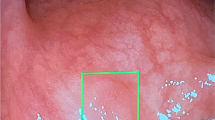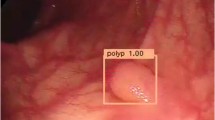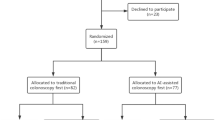Abstract
Purpose of review
This review highlights the history, recent advances, and ongoing challenges of artificial intelligence (AI) technology in colonic polyp detection.
Recent findings
Hand-crafted AI algorithms have recently given way to convolutional neural networks with the ability to detect polyps in real-time. The first randomized controlled trial comparing an AI system to standard colonoscopy found a 9% increase in adenoma detection rate, but the improvement was restricted to polyps smaller than 10 mm and the results need validation. As this field rapidly evolves, important issues to consider include standardization of outcomes, dataset availability, real-world applications, and regulatory approval.
Summary
AI has shown great potential for improving colonic polyp detection while requiring minimal training for endoscopists. The question of when AI will enter endoscopic practice depends on whether the technology can be integrated into existing hardware and an assessment of its added value for patient care.


Similar content being viewed by others
References and Recommended Reading
Papers of particular interest, published recently, have been highlighted as: • Of importance •• Of major importance
Bray F, Ferlay J, Soerjomataram I, Siegel RL, Torre LA, Jemal A. Global cancer statistics 2018: GLOBOCAN estimates of incidence and mortality worldwide for 36 cancers in 185 countries. CA Cancer J Clin. 2018;68:394–424. https://doi.org/10.3322/caac.21492 .
Cronin KA, Lake AJ, Scott S, Sherman RL, Noone AM, Howlader N, et al. Annual report to the nation on the status of cancer, part I: national cancer statistics: annual report national cancer statistics. Cancer. 2018;124:2785–800. https://doi.org/10.1002/cncr.31551 .
Siegel RL, Miller KD, Fedewa SA, Ahnen DJ, Meester RGS, Barzi A, et al. Colorectal cancer statistics, 2017: colorectal cancer statistics, 2017. CA Cancer J Clin. 2017;67:177–93. https://doi.org/10.3322/caac.21395 .
Rex D, Cutler C, Lemmel G, Rahmani E.Y., Clark D.W., Helper D.J., Lehman G.A., Mark D.G. (1997) Colonoscopic miss rates of adenomas determined by back-to-back colonoscopies. Gastroenterology 112:24–28. https://doi.org/10.1016/S0016-5085(97)70214-2.
Heresbach D, Barrioz T, Lapalus MG, Coumaros D, Bauret P, Potier P, et al. Miss rate for colorectal neoplastic polyps: a prospective multicenter study of back-to-back video colonoscopies. Endoscopy. 2008;40:284–90. https://doi.org/10.1055/s-2007-995618 .
Rex DK, Boland CR, Dominitz JA, Giardiello FM, Johnson DA, Kaltenbach T, et al. Colorectal cancer screening: recommendations for physicians and patients from the U.S. multi-society task force on colorectal cancer. Gastroenterology. 2017;153:307–23. https://doi.org/10.1053/j.gastro.2017.05.013 .
Corley DA, Jensen CD, Marks AR, Zhao WK, Lee JK, Doubeni CA, et al. Adenoma detection rate and risk of colorectal cancer and death. N Engl J Med. 2014;370:1298–306. https://doi.org/10.1056/NEJMoa1309086 .
Castaneda D, Popov VB, Verheyen E, et al (2018) New technologies improve adenoma detection rate, adenoma miss rate, and polyp detection rate: a systematic review and meta-analysis. Gastrointest Endosc 88:209-222.e11. https://doi.org/10.1016/j.gie.2018.03.022 .
Wada Y, Fukuda M, Ohtsuka K, Watanabe M, Fukuma Y, Wada Y, et al. Efficacy of Endocuff-assisted colonoscopy in the detection of colorectal polyps. Endosc Int Open. 2018;06:E425–31. https://doi.org/10.1055/s-0044-101142 .
Atkinson NSS, Ket S, Bassett P, Aponte D, de Aguiar S, Gupta N, et al. Narrow-band imaging for detection of neoplasia at colonoscopy: a meta-analysis of data from individual patients in randomized controlled trials. Gastroenterology. 2019;157:462–71. https://doi.org/10.1053/j.gastro.2019.04.014 .
Hassan C, Senore C, Radaelli F, de Pretis G, Sassatelli R, Arrigoni A, et al. Full-spectrum (FUSE) versus standard forward-viewing colonoscopy in an organised colorectal cancer screening programme. Gut. 2017;66:1949–55. https://doi.org/10.1136/gutjnl-2016-311906 .
Buchner AM, Shahid MW, Heckman MG, McNeil R, Cleveland P, Gill KR, et al. High-definition colonoscopy detects colorectal polyps at a higher rate than standard white-light colonoscopy. Clin Gastroenterol Hepatol. 2010;8:364–70. https://doi.org/10.1016/j.cgh.2009.11.009 .
Subramanian V, Mannath J, Hawkey CJ, Ragunath K. High definition colonoscopy vs. standard video endoscopy for the detection of colonic polyps: a meta-analysis. Endoscopy. 2011;43:499–505. https://doi.org/10.1055/s-0030-1256207 .
Esteva A, Kuprel B, Novoa RA, et al. Dermatologist-level classification of skin cancer with deep neural networks. Nature. 2017;542:115–8. https://doi.org/10.1038/nature21056 .
Thrall JH, Li X, Li Q, Cruz C, Do S, Dreyer K, et al. Artificial intelligence and machine learning in radiology: opportunities, challenges, pitfalls, and criteria for success. J Am Coll Radiol. 2018;15:504–8. https://doi.org/10.1016/j.jacr.2017.12.026 .
Karkanis SA, Iakovidis DK, Maroulis DE, Karras DA, Tzivras M. Computer-aided tumor detection in endoscopic video using color wavelet features. IEEE Trans Inf Technol Biomed. 2003;7:141–52. https://doi.org/10.1109/TITB.2003.813794 .
Maroulis DE, Iakovidis DK, Karkanis SA, Karras DA (2003) CoLD: a versatile detection system for colorectal lesions in endoscopy video-frames. Comput Methods Prog Biomed 70:151–166. https://doi.org/10.1016/S0169-2607(02)00007-X.
Iakovidis DK, Maroulis DE, Karkanis SA. An intelligent system for automatic detection of gastrointestinal adenomas in video endoscopy. Comput Biol Med. 2006;36:1084–103. https://doi.org/10.1016/j.compbiomed.2005.09.008 .
Angermann Q, Bernal J, Sánchez-Montes C, et al (2017) Towards real-time polyp detection in colonoscopy videos: adapting still frame-based methodologies for video sequences analysis. In: Computer assisted and robotic endoscopy and clinical image-based procedures. Springer, pp 29–41.
Wang Y, Tavanapong W, Wong J, Oh JH, de Groen PC. Polyp-alert: near real-time feedback during colonoscopy. Comput Methods Prog Biomed. 2015;120:164–79.
Kaiser D, Haselhuhn T. Facing a regular world: how spatial object structure shapes visual processing. J Neurosci. 2017;37:1965–7. https://doi.org/10.1523/JNEUROSCI.3441-16.2017 .
Billah M, Waheed S, Rahman MM. An automatic gastrointestinal polyp detection system in video endoscopy using fusion of color wavelet and convolutional neural network features. Int J Biomed Imaging. 2017;2017:9.
Zhang R, Zheng Y, Mak TWC, et al. Automatic detection and classification of colorectal polyps by transferring low-level CNN features from nonmedical domain. IEEE J Biomed Health Inform. 2017;21:41–7. https://doi.org/10.1109/JBHI.2016.2635662 .
• Urban G, Tripathi P, Alkayali T, et al (2018) Deep learning localizes and identifies polyps in real time with 96% accuracy in screening colonoscopy. Gastroenterology 155:1069-1078.e8. https://doi.org/10.1053/j.gastro.2018.06.037A real-time polyp detection algorithm shown to improve polyp detection compared with expert review of colonoscopy video.
•• Klare P, Sander C, Prinzen M, et al (2019) Automated polyp detection in the colorectum: a prospective study (with videos). Gastrointest Endosc 89:576-582.e1. https://doi.org/10.1016/j.gie.2018.09.042A real-time algorithm that was tested in vivo during live colonoscopies; its ADR was comparable with, but slightly inferior to, that of endoscopists.
•• Wang P, Berzin TM, Glissen Brown JR, et al (2019) Real-time automatic detection system increases colonoscopic polyp and adenoma detection rates: a prospective randomised controlled study. Gut gutjnl-2018-317500. https://doi.org/10.1136/gutjnl-2018-317500This is the only randomized clinical trial using AI for polyp detection in live patients and found increased ADR compared with standard colonoscopy.
Atkin WS, Morson BC, Cuzick J. Long-term risk of colorectal cancer after excision of rectosigmoid adenomas. N Engl J Med. 1992;326:658–62. https://doi.org/10.1056/NEJM199203053261002 .
Noshirwani KC, van Stolk RU, Rybicki LA, Beck GJ (2000) Adenoma size and number are predictive of adenoma recurrence: implications for surveillance colonoscopy. Gastrointest Endosc 51:433–437. https://doi.org/10.1016/S0016-5107 (00)70444-5.
Martínez ME, Baron JA, Lieberman DA, Schatzkin A, Lanza E, Winawer SJ, et al. A pooled analysis of advanced colorectal neoplasia diagnoses after colonoscopic polypectomy. Gastroenterology. 2009;136:832–41. https://doi.org/10.1053/j.gastro.2008.12.007 .
Saini SD, Kim HM, Schoenfeld P. Incidence of advanced adenomas at surveillance colonoscopy in patients with a personal history of colon adenomas: a meta-analysis and systematic review. Gastrointest Endosc. 2006;64:614–26. https://doi.org/10.1016/j.gie.2006.06.057 .
Rex DK, Schoenfeld PS, Cohen J, Pike IM, Adler DG, Fennerty MB, et al. Quality indicators for colonoscopy. Gastrointest Endosc. 2015;81:31–53. https://doi.org/10.1016/j.gie.2014.07.058 .
• Bernal J, Tajkbaksh N, Sánchez FJ, et al (2017) Comparative validation of polyp detection methods in video colonoscopy: results from the MICCAI 2015 endoscopic vision challenge. IEEE Trans Med Imaging 36:1231–1249 Describes results of the first and only attempt to compare the performance of multiple algorithms directly in a standardized manner.
• Rex DK, Kahi C, O’Brien M, et al (2011) The American Society for Gastrointestinal Endoscopy PIVI (preservation and incorporation of valuable endoscopic innovations) on real-time endoscopic assessment of the histology of diminutive colorectal polyps. Gastrointest Endosc 73:419–422. https://doi.org/10.1016/j.gie.2011.01.023ASGE statement establishing criteria for incorporation of polyp classification technology into practice.
Russakovsky O, Deng J, Su H, et al. ImageNet large scale visual recognition challenge. Int J Comput Vis. 2015;115:211–52. https://doi.org/10.1007/s11263-015-0816-y .
de Lange T, Halvorsen P, Riegler M. Methodology to develop machine learning algorithms to improve performance in gastrointestinal endoscopy. World J Gastroenterol. 2018;24:5057–62. https://doi.org/10.3748/wjg.v24.i45.5057 .
Yu L, Chen H, Dou Q, et al. Integrating online and offline three-dimensional deep learning for automated polyp detection in colonoscopy videos. IEEE J Biomed Health Inform. 2017;21:65–75. https://doi.org/10.1109/JBHI.2016.2637004 .
Artificial Intelligence for the American People. In: White House. https://www.whitehouse.gov/ai/. Accessed 12 Oct 2019.
Edwards L, Veale M. Enslaving the algorithm: from a “Right to an Explanation” to a “Right to Better Decisions”? IEEE Secur Priv. 2018;16:46–54. https://doi.org/10.1109/MSP.2018.2701152 .
Price WN, Gerke S, Cohen IG. Potential liability for physicians using artificial intelligence. JAMA. 2019. https://doi.org/10.1001/jama.2019.15064.
Chen P-J, Lin M-C, Lai M-J, Lin JC, Lu HH, Tseng VS. Accurate classification of diminutive colorectal polyps using computer-aided analysis. Gastroenterology. 2018;154:568–75.
Byrne MF, Chapados N, Soudan F, Oertel C, Linares Pérez M, Kelly R, et al. Real-time differentiation of adenomatous and hyperplastic diminutive colorectal polyps during analysis of unaltered videos of standard colonoscopy using a deep learning model. Gut. 2019;68:94–100. https://doi.org/10.1136/gutjnl-2017-314547 .
Gross S, Trautwein C, Behrens A, Winograd R, Palm S, Lutz HH, et al. Computer-based classification of small colorectal polyps by using narrow-band imaging with optical magnification. Gastrointest Endosc. 2011;74:1354–9. https://doi.org/10.1016/j.gie.2011.08.001 .
Kominami Y, Yoshida S, Tanaka S, Sanomura Y, Hirakawa T, Raytchev B, et al. Computer-aided diagnosis of colorectal polyp histology by using a real-time image recognition system and narrow-band imaging magnifying colonoscopy. Gastrointest Endosc. 2016;83:643–9. https://doi.org/10.1016/j.gie.2015.08.004 .
Mori Y, Kudo S, Misawa M, Saito Y, Ikematsu H, Hotta K, et al. Real-time use of artificial intelligence in identification of diminutive polyps during colonoscopy: a prospective study. Ann Intern Med. 2018;169:357–66. https://doi.org/10.7326/M18-0249 .
Takemura Y, Yoshida S, Tanaka S, Onji K, Oka S, Tamaki T, et al. Quantitative analysis and development of a computer-aided system for identification of regular pit patterns of colorectal lesions. Gastrointest Endosc. 2010;72:1047–51. https://doi.org/10.1016/j.gie.2010.07.037 .
Karkanis SA, Iakovidis DK, Maroulis DE, Karras DA, Tzivras M. Computer-aided tumor detection in endoscopic video using color wavelet features. IEEE Trans Inf Technol Biomed. 2003;7:141–52.
Hwang S, Oh J, Tavanapong W, et al (2007) Polyp detection in colonoscopy video using elliptical shape feature. In: 2007 IEEE International Conference on Image Processing. IEEE, pp II-465-II–468.
Park SY, Sargent D, Spofford I, Vosburgh KG, A-Rahim Y. A colon video analysis framework for polyp detection. IEEE Trans Biomed Eng. 2012;59:1408–18. https://doi.org/10.1109/TBME.2012.2188397 .
Bernal J, Sánchez FJ, Fernández-Esparrach G, Gil D, Rodríguez C, Vilariño F. WM-DOVA maps for accurate polyp highlighting in colonoscopy: validation vs. saliency maps from physicians. Comput Med Imaging Graph. 2015;43:99–111.
Tajbakhsh N, Gurudu SR, Liang J. Automated polyp detection in colonoscopy videos using shape and context information. IEEE Trans Med Imaging. 2015;35:630–44.
Geetha K, Rajan C. Automatic colorectal polyp detection in colonoscopy video frames. Asian Pac J Cancer Prev APJCP. 2016;17:4869–73. https://doi.org/10.22034/APJCP.2016.17.11.4869.
Misawa M, Kudo S, Mori Y, et al (2018) Artificial intelligence-assisted polyp detection for colonoscopy: initial experience. Gastroenterology 154:2027-2029.e3. https://doi.org/10.1053/j.gastro.2018.04.003 .
Park SY, Sargent D (2016) Colonoscopic polyp detection using convolutional neural networks. In: Medical imaging 2016: computer-aided diagnosis. International Society for Optics and Photonics, p 978528.
Pogorelov K, Ostroukhova O, Jeppsson M, et al (2018) Deep learning and hand-crafted feature based approaches for polyp detection in medical videos. In: 2018 IEEE 31st international symposium on computer-based medical systems (CBMS). IEEE, Karlstad, pp 381–386.
Ahmad OF, Brandao P, Sami SS, et al. Tu1991 Artificial intelligence for real-time polyp localisation in colonoscopy withdrawal videos. Gastrointest Endosc. 2019;89:AB647. https://doi.org/10.1016/j.gie.2019.03.1135 .
Eelbode T, Hassan C, Demedts I, et al. Tu1959 BLI and LCI improve polyp detection and delineation accuracy for deep learning networks. Gastrointest Endosc. 2019;89:AB632. https://doi.org/10.1016/j.gie.2019.03.1103 .
Ka-Luen Lui T, Yee K, Wong K, Leung WK. 1062 Use of artificial intelligence image classifier for real-time detection of colonic polyps. Gastrointest Endosc. 2019;89:AB135. https://doi.org/10.1016/j.gie.2019.04.175 .
Misawa M, Kudo S, Mori Y, et al. Tu1990 Artificial intelligence-assisted polyp detection system for colonoscopy, based on the largest available collection of clinical video data for machine learning. Gastrointest Endosc. 2019;89:AB646–7. https://doi.org/10.1016/j.gie.2019.03.1134 .
Ozawa T, Ishihara S, Fujishiro M, et al (2018) Novel computer-assisted system for the detection and classification of colorectal polyps using artificial intelligence. UEG Week 2018 Oral Presentations.pdf. United European Gastroenterology Journal, Austria, p A98.
Ozawa T, Ishihara S, Fujishiro M, et al. Sa1971 Automated endoscopic detection and classification of colorectal polyps using convolutional neural networks. Gastrointest Endosc. 2018;87:AB271. https://doi.org/10.1016/j.gie.2018.04.1585 .
Repici A, Dinh NN, Cherubini A, et al. Su1716 Artificial intelligence for colorectal polyp detection: high accuracy and detection anticipation with CB-17-08 performance. Gastrointest Endosc. 2019;89:AB391–2. https://doi.org/10.1016/j.gie.2019.03.589 .
Shichijo S, Aoyama K, Ozawa T, et al. Tu2003 Application of convolutional neural networks could detect all laterally spreading tumor in colonoscopic images. Gastrointest Endosc. 2019;89:AB653. https://doi.org/10.1016/j.gie.2019.03.1147 .
Yamada M, Saito Y, Imaoka H, et al. Development of a real-time endoscopic image diagnosis support system using deep learning technology in colonoscopy. Austria: United European Gastroenterology Journal; 2018. p. A190.
Zheng Y, Mak T, Jiang Y, et al. A study comparing colorectal polyp detection rates between endoscopists and artificial intelligence-doscopist. France: Colorectal Disease; 2018. p. 22.
Zhu X, Nemoto D, Wang Y, et al. Sa1923 Detection and diagnosis of sessile serrated adenoma/polyps using convolutional neural network (artificial intelligence). Gastrointest Endosc. 2018;87:AB251 https://doi.org/10.1016/j.gie.2018.04.445.
Author information
Authors and Affiliations
Corresponding author
Ethics declarations
Conflict of Interest
Nicholas Hoerter declares no conflict of interest. Peter Liang reports grants from Epigenomics, outside the submitted work. Seth Gross reports personal fees from Olympus, outside the submitted work.
Human and Animal Rights and Informed Consent
This article does not contain any studies with human or animal subjects performed by any of the authors.
Additional information
Publisher’s Note
Springer Nature remains neutral with regard to jurisdictional claims in published maps and institutional affiliations.
This article is part of the Topical Collection on Colon
Rights and permissions
About this article
Cite this article
Hoerter, N., Gross, S.A. & Liang, P.S. Artificial Intelligence and Polyp Detection. Curr Treat Options Gastro 18, 120–136 (2020). https://doi.org/10.1007/s11938-020-00274-2
Published:
Issue Date:
DOI: https://doi.org/10.1007/s11938-020-00274-2




